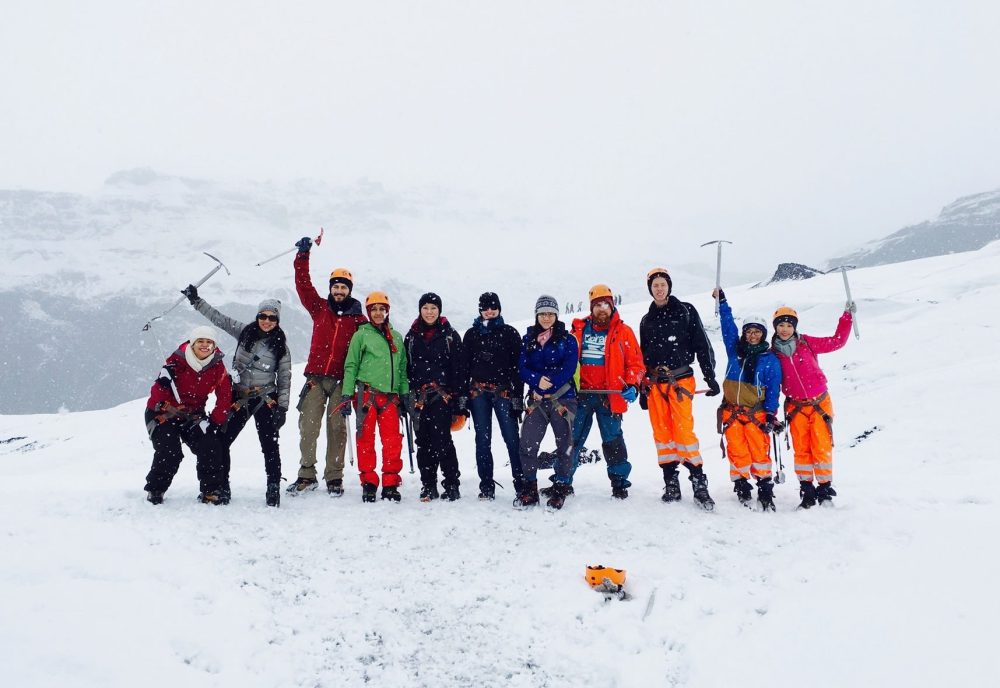A huge number of hikers especially beginners have a hard time dressing up for a winter hike. However, it is very crucial for outdoor enthusiasts to stay warm and comfortable in freezing conditions. Failure to layer up accordingly results in a less enjoyable cold-weather adventure. Still, it exposes hikers to more detrimental risks like hypothermia. All the same, there is no need for alarm. Read on since this article tackles how to layer for winter hiking.

Winter Hiking Gear
Well, before we delve into the layering process, let us first look at the type of gear you need to hike in the cold weather:
- Pants
- Hiking Underwear
- Jackets for cold weather
- Gloves
- Hats
- Winter hiking Boots
- Wool Socks
Hiking Pants
Hiking pants need to be wind and waterproof. In other words, get a hard shell pair of pants to keep the lower body layer weatherproof. In addition, ventilation and breathability are other vital attributes of ideal winter pants.
Hiking Underwear
Such clothes form the base layer. Underwear for hiking has to be light and gentle on the skin. That is not all, its moisture wicking capabilities should be enviable. Merino wool is very effective in maintaining temperature making it ideal for adverse weather conditions. Always, make sure the hiking underwear for women has treated with anti-microbial agents for improved hygiene.
Jackets for Cold Weather
They come in different dimensions to suit different layers. Nevertheless, look out for insulation, quality of constructions and extra features like hoods. In a like manner, jackets normally make the wind layer and outer shell. Water and wind proofing is equally crucial.
Gloves
Fleece and wool are suitable for winter gloves. They boast of top class moisture wicking and insulation properties. On top of that, the two fabrics are ultra light. Also, get waterproof pair.
Hats
For a flawless time in the jungle, choose a light hat to keep your head warm. Wool and fleece are the best fabrics for such hats.
Winter Hiking boots
The perfect winter hiking boot ought to be insulated, waterproof, and comfortable. In a similar fashion, it has to fit snugly and last long.
Wool socks
Just like hiking boots, hiking socks need to be warm. Socks offer extra comfort as well as added insulation. Similarly, the fabric type matters a lot. Wool and synthetic fabrics are great for winter socks.
How To Layer for Winter Hiking?
Now let us break down how to layer for winter hiking:
- Base Layer
- Mid Layer
- Wind Layer
- Insulation Layer
- Upper body Weather proof Layer
- Lowe Body Weather proof Layer
Base layer
As experts would say, the base layer is your first line of defense. It is closest to your skin. For that, the base layer material must be soft, comfy and gentle on the skin. The first line of defense should keep your skin warm and dry despite the sweat. On the same note, avoid clothes that are tight fitting. This is because they hinder circulation and interfere with movement. Likewise, stay away from cotton. It loses its insulation properties after coming into contact with moisture. Instead, opt for wool or synthetics. Moving on, another vital consideration of this layer is weight. Determine the weight of the base layer depending on the intensity of the cold weather. Therefore, the colder it is, the heavier the base layer should be. Remember to include a base layer on the lower half of the body too.
Mid layer
The mid layer demands light, sweater-like pieces. In fact, this layer should not stifle you but rather enhance insulation. In other words, it keeps your body from losing heat. Still, most items used for this layer heighten breathability and reinforce the windproof layer. Synthetic materials are preferred for the mid layer. They include polyester jackets, fleece among other options. Nonetheless, merino is another great option if you are not into synthetic fabric.
Wind layer
It is essential for the mid layer to be wind resistant. That is why you might have to throw in a light wind jacket. Cutting gusts are a major problem during the cold season. Wind jackets provide adequate protection against that.
Insulation layer
First, the insulation layer needs to be relatively thicker than the previous layers. As a result, puffy jackets are a common choice for the insulation layer. They are comfortable and easy to take off when it gets too warm. Aside from that, insulation layer works to curb heat loss even when temperatures take a life-threatening nosedive.
Upper body weatherproof layer
With a reliable weatherproof layer, you can hike in the rain, snow or gusts worry free. Moreover, it is the most important part of an efficient layering system as it forms the outer shell. Actually, the outer shell could be hard or soft as per the prevailing conditions. Of course, jackets make the best weatherproof layer. Yet, it is imperative to throw on a well-ventilated piece. Look out for ones with pit zips for added breathability.
Lower body weatherproof layer
The lower body also needs protection against extreme rains, winds, or snow just like the upper half. Hence, you need a pair of weather resistant pants for that. Make sure ankles are zippered so that you can wear the pants over boots. Furthermore, it elevates ventilation.
Here are answers to FAQs relating to how to layer for winter hiking:
How do layers stay warm?
Cloth layers create a layer of air between each other and the skin. This layer acts as a medium of insulation thus preventing heat loss.
Are jeans okay for hiking?
Jeans are not a wise choice for hiking especially in cold weather. They may be okay for hiking under favorable weather conditions but not suitable for hardcore hiking.
Why is cotton bad for hiking?
To begin with, cotton does not dry fast enough hence inhibiting insulation. Actually, hiking clothing should dry fast hence help in maintain body warmth. On the contrary, cotton soaks up with sweat. This effect could culminate in hypothermia.
Which material is the best for winter jackets?
Wool is the ideal fabric for winter jackets. It is preferred courtesy of its reliable insulation. Not only is it long lasting, but also moisture resistant. Modern day jackets feature a blend of wool and synthetic materials.
Conclusion
You can finally hit the trail worry free, even in freezing weather, now that you have formidable knowledge on how to layer for winter hiking. Above all, if your used hiking gear occupying more space and you want to cash it before your next trail, learn here.
Add The Sports Daily to your Google News Feed!
